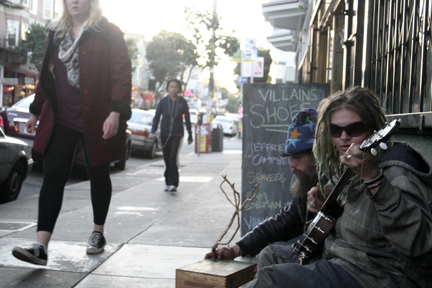San Francisco bracing for sit/lie ordinance

By Matthew Gomez
The Guardsman
John Chovan doesn’t always know who’s telling him to move because he lost his glasses.
It could be a business owner, a pedestrian or a police officer. He complies to avoid any trouble, but sometimes he just needs a place to sit.
This month San Francisco’s Civil Sidewalks Ordinance could stop Chovan, a homeless man in the Tenderloin, from resting his legs.
The ordinance, commonly known as “Sit/Lie”, will make sitting or lying on a public sidewalk unlawful between 7 a.m. and 11 p.m.
First-time offenders will be issued a warning and asked to stand. Their names will go into a computer database, and repeat offenders will be fined and could face jail time.
The ordinance went into effect Dec. 17, 2010 but is not yet being enforced. The San Francisco Police Department is still training officers so they understand how to enforce the ordinance. Since “Sit/Lie” was a voter approved initiative, the SFPD does not have a say in how the ordinance is enforced.
“We weren’t going to do it until everyone was trained,” SFPD spokesman Lt. Troy Dangerfield said. “It has to be done fairly.”
The ordinance allows for exceptions, like for those who are disabled or require medical attention. Both sidewalk vendors and participants in events like parades and protests are also exempt so long as they have the proper permits.
Opponents of the ordinance fear it will be used as a tool to punish the city’s homeless population.
“Using such a broad law to essentially clean up the streets is wrong,” said Alan Schlosser, legal director for the American Civil Liberties Union of Northern California.
Schlosser said that although criminalizing specific actions — like the harassment of pedestrians — is acceptable, making sitting illegal doesn’t address those issues.
Michael Browne, a program director at Youth with a Mission in the Tenderloin, doesn’t see the point in fining people for having nowhere else to go.
“It doesn’t solve any problems,” Browne said. “Were we supposed to sweep them under the rug?”
Browne works directly with the homeless community in the Tenderloin, and the YWAM facilities allow them a shelter to rest, eat and bathe. Since they have no address of their own, many patrons even receive mail through YWAM.
Around 1,200 homeless people shuffle through YWAMs doors every month, Browne said. Their doors are only open Monday through Friday from 9:30 a.m. to 4:30 p.m., which means after that it’s back to the streets for the patrons.
Browne said there needs to be more people working with the homeless rather than punishing them for their situation.
“People just don’t want to have to look at poverty,” he said.
To Ted Loewenberg, president of the Haight-Ashbury Improvement Association, the goal of the Civil Sidewalks Ordinance is to bring peace back to the neighborhood. He said aggressive panhandlers and large groups of unruly sidewalk dwellers have deterred many people from visiting Haight Street.
“This is a law that targets behavior,” Loewenberg said. “People have expressed their limit of abuse.”
Last year the SFPD performed a few small-scale busts of rambunctious groups, and Loewenberg said the response from the community was positive.
“The real message here is that the people, the voters of San Francisco have spoken very clearly on this subject,” Loewenberg said.
Chovan just tries to be invisible. He switches spots throughout the day to avoid becoming an eyesore.
“If they tell me to move along, I move along,” Chovan said. “I try not to hang around too much.”

Comments are closed.